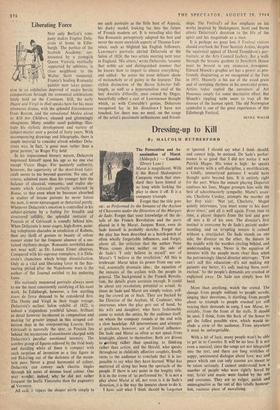Liberating Force
NOT only Berlioz's com- pany makes Eugene Dela- croix at home in Edin- burgh. The portico of the Scottish Academy, sur- mounted by a youngish Queen Victoria exotically supported by sphinxes, is close neighbour to the Walter Scott memorial.
i France's leading Romantic painter now takes posses- sion in an exhibition deprived of major heroic compositions through the centennial celebrations lately held on the Continent. Still, the early Dante and Virgil in Hell speaks here for his most strenuous drama, with the splendid Entombment from Boston, and the sensational Medea about to Kill her Children, cleaned and glisteningly oleaginous. Many smaller easel paintings illus- trate his stylistic development and variety of subject-matter over a period of forty years. With accompanying drawings and lithographs, there is ample material to consider afresh whether Dela- croix was, in fact, 'a great man rather than a great painter,' as Roger Fry held.
In his impassioned literary nature, Delacroix impressed himself upon his age as no one else except Victor Hugo. For painterly authority, however, the superiority of the short-lived Geri- cault seems to me beyond question. No one, of course, admired more than his younger heir the balande of classical, romantic, and realist ele- ments which Gericault perfectly achieved in Rome, so that even when he becomes absorbed in studies of insane patients he never forces the note, is never extravagant or rhetorical purely. Whenever Delacroix's emotion is controlled in his subject-pictures by a feeling for breadth and structured solidity, the splendid restraint of Poussin or of Gericault is soundly behind him. When Delacroix is most stagey, high-flown, paint- ing voluptuous charades in emulation of Rubens, then any thrill of gesture or beauty of colour cannot atone for the frequent absence of a sus- tained rhythmic design. 'Romantic terribilita does not wear well,' as Dr. Lorenz Eitner observes. Compared with his supreme exemplars, it is Dela- croix's chanciness which brings dissatisfaction. Only as a vital and liberating force in the fluc- tuating period after the Napoleonic wars is the author-of the Journal entitled to his enduring fame.
His variously mannered portraits always seem to me the most consistently satisfying of his easel work. In Edinburgh, however, a few startling tours de force demand to be considered first. The Dante and Virgil in their tragic voyage, Delacroix's earliest Salon exhibit of 1822, is indeed a stupendous youthful labour, brilliant in detail however incoherent in composition and making far greater impact in this scraped col- lection than in the overpowering Louvre. Here G6ricault is naturally the spur, as Poussin lies behind the mysterious Entombment charged with Delacroix's peculiar emotional intensity. The sombre group of figures relieved by the livid body and dazzling white of linen is compact with such surprises of invention as a tiny figure in red flickering out of the darkness of the moun- tain pass. Never a great harmonist of colour, Delacroix can convey such electric tingles through his notes of intense local colour. One may wonder, indeed, why he did not rather frequent the hectic Tintoretto than the pageantry of Veronese.
All said, it repays the sleeper north simply to
see such portraits as the little bust of Aspasia, his dusky model, looking far into the future of French modern art. It is revealing also that this Romantic perceptively adapted the best and never the more mawkish aspects of Thomas Law- rence, such as blighted his English followers. Lawrence's portraits alerted Delacroix at the Salon of 1824, the two artists meeting next year in England. 'His sitters,' wrote Delacroix, 'assume that noble air and distinguished manner that he knows how to impart to almost everything,' and added : 'he seizes the most delicate shade of melancholy or of gaiety in the features.' The stylish distinction of the Baron Schwiter full- length, as well as a hypersensitive oval of the boy Amildee d'Ouville, once owned by Degas, beautifully reflect a cast of Lawrencean thought which, as with Constable's genius, Delacroix recognised lay in his direction.. I have not touched, for there was no need, on the range of the artist's passionate enthusiasms and friend- ships. The Festival's ad hoc emphasis on his works inspired by Shakespeare, Scott and Burns attests Delacroix's devotion to the life of the spirit and his magnitude as a man.
It is perhaps no great loss if Festival visitors should overlook the 'Four Scottish Artists,' despite the equivocal appeal of David Donaldson's por- traiture, at the Arts Council Gallery. But a walk through the botanic gardens to Inverleith House must be braved in any monsoon downpour. Edvard Munch's graphic art has a power as pro- foundly disquieting as we recognised at the Tate in 1951. Masterly is his use of the wood grain and of sweeping rhythms in his emotional prints. Artists today exploit the curvature of Art Nouveau simply for some decorative effect. But Munch's rippling webs seem to trap all the stresses of the human spirit. The old Norwegian symbolist is one of the great experiences of this Edinburgh Festival.
NEVILE WALLIS


































 Previous page
Previous page